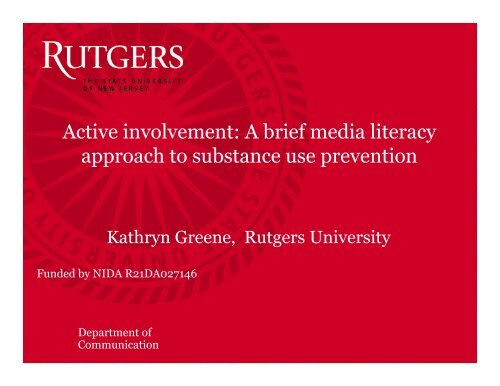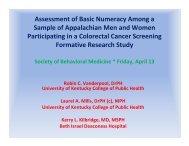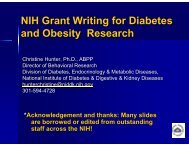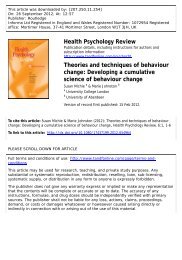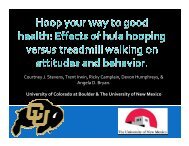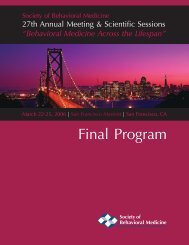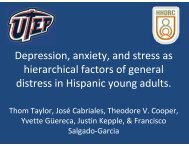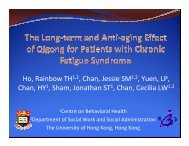Active Involvement
Active Involvement
Active Involvement
- No tags were found...
Create successful ePaper yourself
Turn your PDF publications into a flip-book with our unique Google optimized e-Paper software.
<strong>Active</strong> involvement: A brief media literacyapproach to substance use preventionKathryn Greene, Rutgers UniversityFunded by NIDA R21DA027146Department ofCommunication
Department ofCommunicationIntroduction: Contributions of Communication• Many fields focus on prevention and/or interventions• Communication expertise in content but how to apply?• How to optimally refine programs to use theory tomaximize interventions and message content2
Department ofCommunicationExample: <strong>Active</strong> <strong>Involvement</strong> Interventions• Limited intervention opportunities (time, cost)• Little theoretical guidance for which interventioncomponents are crucial or “active”• Emphasize how to involve participants in interventions• What is the theory behind using message planning orproduction?• Greene, K., & Hecht, M. L. (in press). Introduction for Symposium on engaging youth inprevention message creation: The theory and practice of active involvement interventions. HealthCommunication.3
Department ofCommunication<strong>Active</strong> <strong>Involvement</strong> Interventions (AIIs)• Two categories of interventions using message planning• 1. Adolescents create messages as strategy for messagedevelopment (e.g., CBPR)• Greene, K. (in press). The Theory of <strong>Active</strong> <strong>Involvement</strong>: Processes underlying interventionsthat engage adolescents in message planning and/or production. Health Communication.4
Department ofCommunication<strong>Active</strong> <strong>Involvement</strong> Interventions (AIIs)• Two categories of interventions using message planning• 2. Adolescents develop/plan as a strategy for influencewithin an intervention• Develop Theory of <strong>Active</strong> <strong>Involvement</strong> (TAI)• Greene, K. (in press). The Theory of <strong>Active</strong> <strong>Involvement</strong>: Processes underlying interventionsthat engage adolescents in message planning and/or production. Health Communication.5
Theory of <strong>Active</strong> <strong>Involvement</strong> (TAI)Department ofCommunication• Grounded in social cognitive theory (Bandura, 1986)• Notion of self-regulation• Create intervention to emphasize multiple perspectivetaking and evaluating discrepancy• Emphasize engagement with intervention as a keymissing component to date [and knowledge and skills assecondary to lasting change]• Greene, K. (in press). The Theory of <strong>Active</strong> <strong>Involvement</strong>: Processes underlying interventionsthat engage adolescents in message planning and/or production. Health Communication.6
Department ofCommunicationMedia Literacy (ML) as an example of AIINew and promising avenue for prevention– ML expands traditional literacy and uses literacy tools to analyzemedia– ML training can include analysis and production (or planning)componentsML training/interventions addressing alcohol– Overall favorable results (i.e., reduction in specific beliefs, attitudes,and intentions) for elemen. and middle school kids– Can improve cognitive resistance to ads7
Curriculum Ad to Generate DiscussionDepartment ofCommunication8
Department ofCommunicationCritiques of ML Interventions• Lack of clarity about the causal process– No explanations of why and how the participants change attitudeand/or behavior when exposed to these programs• Failure to form students’ engagement– ML interventions generally fail to form students’ motivation to resistsuch influences (focus on knowledge or skill acquisition)• Unclear optimal dose and length of expected effects• Rarely tailored– Missing adequate tailoring to the cognitive capabilities anddevelopmental stage of the target audience9
Department ofCommunicationInitial Study: Smoking• Targeting middle school smoking using ML intervention in 2schools, 2 lesson intervention (about 75 minutes)• 3 conditions: control, analysis, planning• Planning reported negative anti-smoking attitudes and lowerintentions to smoke; analysis also less favorable smokingattitudes and intentions than control• Thus:– Planning > Analysis > Control• Produce evidence that involving adolescents actively ingenerating messages provides a more powerful strategy ofusing ML in preventionBanerjee, S. C., & Greene, K. (2007). Anti-smoking initiatives: Examining effects of inoculation based media literacyinterventions on smoking-related attitude, norm, and behavioral intention. Health Communication, 22, 37-48.Banerjee, S. C., & Greene, K. (2006). Analysis versus production: Adolescent cognitive and attitudinal responses to antismokinginterventions. Journal of Communication, 56, 773-794. 10
Department ofCommunicationNIDA Study 2010-2012• Grounded in theories of persuasion and information processing;designed to test hypotheses about the process of cognitive change• Feasibility of a brief ML intervention (limited resources)• Planning versus analysis conditions• Alcohol-focused• Brief (90 minutes)Greene, K. (2010-2112), Principal Investigator. Grant #R21 DA027146 from the National Institutes ofHealth's National Institute on Drug Abuse (NIDA) for project "<strong>Active</strong> <strong>Involvement</strong> in Creating HighSchool Substance Use Prevention Messages."11
Department ofCommunicationStructure of YMD Curriculum (+ ex’s, discussion)• Introduction• Target audience, persuasion techniques (4 main ones), claims• Activity 1: Analyze alcohol ad in group• Counter-arguing or missing from ads, anti-ads• Attention, production techniques• Activity 2: Planning anti-alcohol poster• Conclusion (and evaluation)12
Department ofCommunicationPhase 1 – 2010 Pilot of preliminary curriculum: StudentsMethod•149 10 th grade high school students (ages 14-16; M = 15.57, SD = .61)•32 schools across Pennsylvania attending Leadership InstituteResults•The pilot poster planning students viewed the intervention as morenovel (t(146) = -2.92, p < .001) and more involving (t(146) = -2.23, p
Department ofCommunication14
Department ofCommunicationPhase 2: 2010 Pilot of preliminary curriculum: MentorsMethod•Mentors accompany students (N = 40; ages 20 to 65, M = 37.38,SD = 13.05) also evaluated the curriculum.•Teachers (64%), counselors (14.5%), administrators (6.5%),youth agency workers (4%), or other (11%).Results•Mentors reported planning was more involving (t(38) = -3.48, p
Department ofCommunicationRefining Curriculum: Additional FormativeMethod:2 teacher focus groups,2 student focus groups,20 student interviews,6 mentor (teacher) interviews.Results•Specific ads to incorporate (e.g., Pdiddy), balance main ads•Activity Sheets restructured to improve involvement•Clarify curriculum procedures, Activity 2 instructions•Refine measurement16
Department ofCommunicationAdditional test of YMD curriculum (2011)3 waves using Leadership Program students in PAAnalysis vs. Planning (with small control)171 10 th graders, 34 schools across PARevisions emphasized planning component of the posterplanning activity17
Department ofCommunicationAdditional studies• Focus on measures of motivation to tap involvement• Greene, K., Yanovitzky, I., Magsamen-Conrad, K., Elek, E., Banerjee, S. C., Hecht, M. L., &Carpenter, A. A theory-grounded measure of target audiences’ motivations to process medialiteracy interventions.• Focus on analysis of posters planned/produced ininterventionsBanerjee, S. C., Greene, K., Hecht, M. L., Magsamen-Conrad, K. C., & Elek, E. (in press).“Drinking won’t get you thinking”: A content analysis of adolescent-created print alcohol counteradvertisements. Health Communication.• Focus on measure of counter-arguing–Validity study of skills measure to ascertain overlap with scales18
Department ofCommunicationFuture Research•<strong>Active</strong> involvement interventions– Theory about process– Necessary and sufficient components•Ensuring that interventions can be utilized by communitypartners•How communication scholars can contribute to this question19
Department ofCommunication• Questions?• Contact– klgreene@rutgers.edu20


